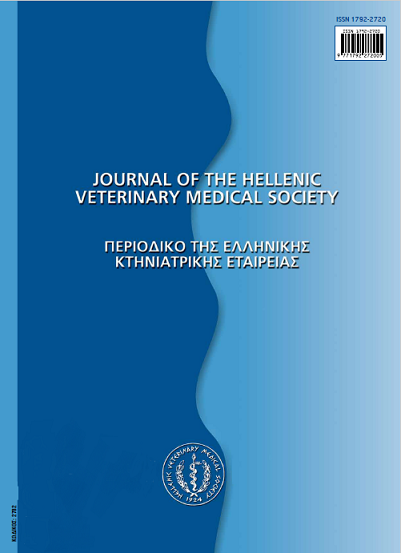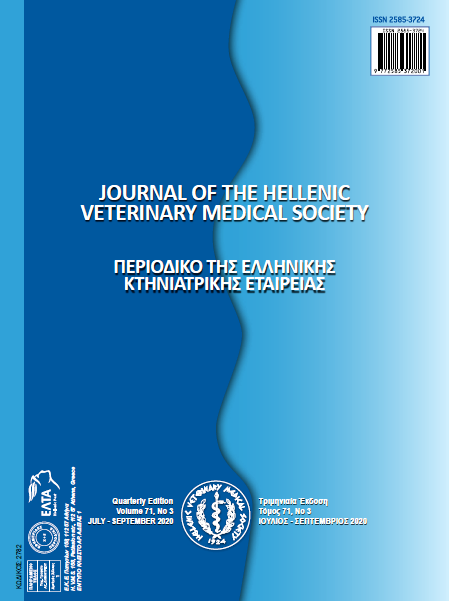Συμβολή στα παράσιτα και τη σχετική παθολογία των άγριων σερανοϊδών από το Αιγαίο

Περίληψη
Στη παρούσα μελέτη παρουσιάζονται παρασιτώσεις και οι παθολογικές καταστάσεις που προκαλούν, σε άγρια Σερανιδοειδή που συλλέχθηκαν από διάφορες περιοχές του Αιγαίου Πελάγους. Παρατηρήθηκαν διάφορες βλάβες και παρασιτικοί οργανισμοί, όπως Διγενή παράσιτα, κύστεις και μετακερκάρια, κύστεις Κεστωδών και ένα νηματώδες παράσιτο, στα βράγχια / ψευδοβράγχια, στο ήπαρ, στα τοιχώματα του πεπτικού σωλήνα, στο μεσεντέριο και στις ωοθήκες. Καμία από αυτές τις βλάβες δεν αποδόθηκε σε παθογόνα βακτήρια. Ο συχνότερα παρατηρούμενος παρασιτισμός μεταξύ όλων των ειδών που ελέγχθηκαν ήταν από Διγενή παράσιτα (11 από τα 16 δείγματα που εξετάστηκαν) σε σύγκριση με τις μολύνσεις από Κεστώδη και Νηματώδη παράσιτα (3 από τα 16 δείγματα που εξετάστηκαν). Η πιο έντονη παρασίτωση παρατηρήθηκε από κύστεις ενός αταυτοποίητου Διγενούς παρασίτου που βρέθηκαν στο μεσεντέριο ενός από τα ψάρια που ελέγχθηκαν (120 παράσιτα), ακολουθούμενη από τη παρασίτωση με τα Διδυμόζωα παράσιτα (κατά μέσο όρο 19,25 παράσιτα ανά άτομο).
Λεπτομέρειες άρθρου
- Πώς να δημιουργήσετε Αναφορές
-
BAKOPOULOS, V., NIKOLAIDIS, A., KOLYGAS, M., & ATHANASSOPOULOU, F. (2018). Συμβολή στα παράσιτα και τη σχετική παθολογία των άγριων σερανοϊδών από το Αιγαίο. Περιοδικό της Ελληνικής Κτηνιατρικής Εταιρείας, 68(4), 599–606. https://doi.org/10.12681/jhvms.16058
- Τεύχος
- Τόμ. 68 Αρ. 4 (2017)
- Ενότητα
- Research Articles

Αυτή η εργασία είναι αδειοδοτημένη υπό το CC Αναφορά Δημιουργού – Μη Εμπορική Χρήση 4.0.
Οι συγγραφείς των άρθρων που δημοσιεύονται στο περιοδικό διατηρούν τα δικαιώματα πνευματικής ιδιοκτησίας επί των άρθρων τους, δίνοντας στο περιοδικό το δικαίωμα της πρώτης δημοσίευσης.
Άρθρα που δημοσιεύονται στο περιοδικό διατίθενται με άδεια Creative Commons 4.0 Non Commercial και σύμφωνα με την άδεια μπορούν να χρησιμοποιούνται ελεύθερα, με αναφορά στο/στη συγγραφέα και στην πρώτη δημοσίευση για μη κερδοσκοπικούς σκοπούς.
Οι συγγραφείς μπορούν να καταθέσουν το άρθρο σε ιδρυματικό ή άλλο αποθετήριο ή/και να το δημοσιεύσουν σε άλλη έκδοση, με υποχρεωτική την αναφορά πρώτης δημοσίευσης στο J Hellenic Vet Med Soc
Οι συγγραφείς ενθαρρύνονται να καταθέσουν σε αποθετήριο ή να δημοσιεύσουν την εργασία τους στο διαδίκτυο πριν ή κατά τη διαδικασία υποβολής και αξιολόγησής της.



